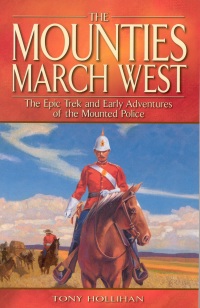| ________________
CM . . .
. Volume XI Number 8 . . . . December 10, 2004
excerpt: As MacDonald read Butler's estimates on the number of Natives - about 18,000, including 2000 Métis - he was well aware that such populations could create significant barriers to peace in the North-West Territories. Especially troublesome were Butler's observations on the hostile relationship between the Blackfoot and the Cree. As traditional enemies, bloodshed appeared inevitable whenever they met. Butler considered the conflict a significant problem, particularly given that the Cree, who traded more, were often around the trading posts. When the Blackfoot occasionally came in to trade, the inevitable violence between the two tribes threatened traders and settlers. MacDonald paused and recalled reports of an especially violent Native encounter in the autumn of 1870. Some 700 Cree and Assiniboine and attacked the Blackfoot near Fort Whoopup, an American whiskey traders' post near the junction of the St. Mary's and Old Man's Rivers. The Blackfoot launched a counterattack that left as many as 300 Cree and 40 Blackfoot dead. Eyewitnesses claimed that the river ran red with blood as the current swept bodies away. Clearly Butler was not underestimating the animosity between the tribes. The Mounties March West tells the story of the creation in the 1870s of what became the Royal Canadian Mounted Police, their travel to western Canada, and the early days of their relationship with the Native population. It is an exciting story told with enthusiasm. As a result, the reader is hooked from page 1 of the Prologue. Author Tony Hollihan has written a number of popular books for young readers, including Great Chiefs, Volumes I and II. With a Master's degree in Canadian and American history, as well as a Ph.D in education, he has mastered the technique of making history come alive. The Mounties March West is illustrated throughout with black and white photographs of the major personalities in the story. These make the story more meaningful than a simple record of names could do. It is also illustrated with drawings of historical scenes, relevant to the story, by Henri Julien. An illustrator with the Canadian Illustrated News, Julien accompanied the Mounties on the westward journey. His work is very fine and helps to make the story come alive. Well researched and factual, the book could be used as a supplementary text in a Canadian history course, or be read for pleasure. Readers will find that history can be very interesting. The stories of the Mounties and their adventures are fascinating. By writing of these adventures, Hollihan proves again that truth can be more interesting than fiction. There is neither an index nor a glossary in The Mounties March West. These are serious shortcomings and reduce the book's usefulness. Readers will be frustrated and for reference purposes will have to write down information and the page numbers on which it is located instead. The lack of a glossary means that readers wanting an explanation for terms such as Royal Assent and the Hudson Bay Company will have to look elsewhere, also a frustration. The book does have a list of the sources Hollihan used which will prove helpful for anyone wishing to learn more about the early history of the RCMP. Most of the individuals encountered in the story were remarkable men. They had to be to survive under the harsh conditions forced on them as they headed west and later as they established themselves as the police on the Canadian prairies. That they succeeded is due, in large part, to outstanding leadership. Brief biographies of these leaders are included. They are excellent. Young readers may be confused by the title. Most of Northwestern Ontario in the 1870s was untamed wilderness. In order to cross it, the police recruits travelled by boat wherever possible, but also had to struggle across "nearly 50 portages of corduroy roads." As a result of the difficult terrain, it is unlikely that any marching took place at all. The spit and polish associated with today's Mounties came much later. Recommended. Thomas F. Chambers is a retired college teacher who lives in North Bay, ON.
To comment
on this title or this review, send mail to cm@umanitoba.ca.
Copyright © the Manitoba Library Association. Reproduction for personal
use is permitted only if this copyright notice is maintained. Any
other reproduction is prohibited without permission.
NEXT REVIEW |TABLE OF CONTENTS FOR THIS ISSUE
- December 10, 2004.
AUTHORS
| TITLES | MEDIA REVIEWS
| PROFILES
| BACK ISSUES
| SEARCH | CMARCHIVE
| HOME |
